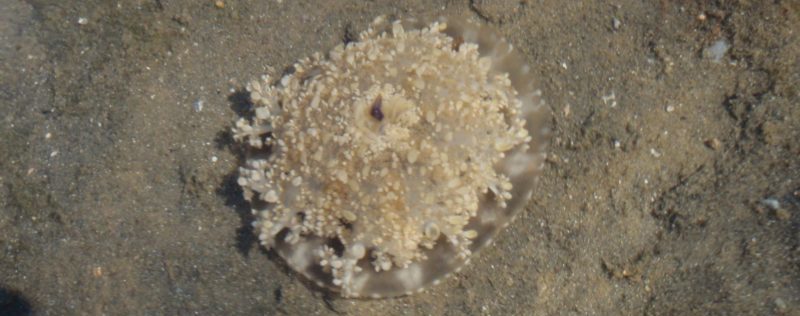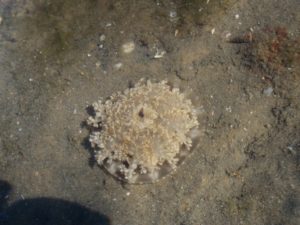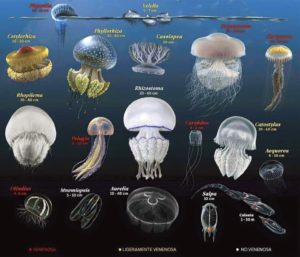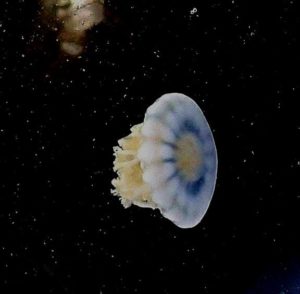The last thing that I expected to be doing on the first days of my recent retirement from work was studying jellyfish, but that’s exactly what happened! That’s just the way that things go sometimes. It all started over the Queen’s Birthday holiday long weekend last June though, as far as I can determine. That was the weekend that I decided to go kayaking alone at Garden Island. I think that I noticed an upside-down jellyfish in the shallow water at the edge of the Port Adelaide River near the Garden Island boat ramp. I took this one photo of the jellyfish before heading out in my kayak.
The upside-down jellyfish, Cassiopea ndrosia
(Taken by Steve Reynolds)
When I reviewed my photos back at home, I decided that it would be a good idea to post my photo of the jellyfish on the Facebook page with the unfortunate name of “I Friggin’ Love Jellyfish” (https://www.facebook.com/groups/1461637340746816/ ). I was glad to receive a response from Rapzkie Geson late in September, saying just “Cassiopea sp.” I was pleasantly surprised to receive a response from jellyfish expert Lisa-ann Gershwin in December, saying “Cassiopea ndrosia. Lovely!! Any chance I can get your permission to use your photo in The Jellyfish App? With attribution, of course!” My immediate response was, “Absolutely Lisa, thanks for that.”
I subsequently posted copies of my jellyfish photo on our own Marine Life Society of SA Facebook page and the SA Natureteers page, with comments such as “I found this little up-side down jellyfish in the shallows of the Port Adelaide River at Garden Island”.
Lisa-ann soon added another post to the “I Friggin Love Jellyfish” page, saying “G’day friends, It is with extreme excitement and blushing pride that I announce that The Jellyfish App is now available on the App Store. The Android version should be released in a matter of just days. Both pro (US$1.99 / AU$2.99) and free versions are available.
The Jellyfish App is a one-stop resource for safety and identification of jellyfish of the world. It currently features about 250 of the world’s most visible species, along with the less visible, more dangerous ones. The App is suitable for divers, fishers, tourism operators, beach combers, naturalists, and others interested in squishy beasts.
Anyone wanting to contribute images of any species, particularly those not yet uploaded, will be gratefully acknowledged. Of course! Cheers, Lisa-ann Gershwin”
I’m unable to install “The Jellyfish app free’ on my old i-Phone.
I recorded my jellyfish discovery (with photo) to the Atlas of Living Australia (http://www.ala.org.au/ ). It seems that there had only been one previous record and no photos had ever been provided to the Atlas.
According to the Atlas, Cassiopea ndrosia was described by Agassiz & Mayer 117 years ago in 1899. According to Wikipedia (https://en.wikipedia.org/wiki/Cassiopea) Cassiopea (upside-down jellyfish) is a genus of true jellyfish and the only members of the family Cassiopeidae. They are found in warmer coastal regions around the world, including shallow mangrove swamps, mudflats, canals, and turtle grass flats in Florida, and the Caribbean. The medusa usually lives upside-down on the bottom, which has earned them the common name. Where found, there may be numerous individuals with varying shades of white, blue, green and brown. They have a mild sting bean since they are primarily photosynthetic, but sensitive individuals may have a stronger reaction. The photosynthesis occurs because, like most corals, they host zooxanthellae in their tissues. The stinging cells are excreted in a mucus; swimming over the jellyfish (especially using swim fins) may cause transparent, essentially invisible, sheets of this mucus to be lifted up into the water column, where they are then encountered by unsuspecting swimmers. The stings, appearing in the form of a red rash-like skin irritation, are known for being extraordinarily itchy. Sometimes this jellyfish is picked up by the crab Dorippe frascone (family Dorippidae) and carried on its back. The crab uses the jellyfish to defend itself against possible predators.”
Cassiopea ndrosia features in “Marine Invertebrates of southern Australia – Part I”, edited by SA Shepherd & IM Thomas (1982). It is the last species listed in the Key to Species on pages 120-122. The species is described in detail on page 159, as follows: –
“Medusa to 110 mm wide. Exumbrella flat to slightly concave. Rhopalia 18-22 in number; rhopalar pits smooth, with radial folds. Lappets at edge of umbrella very indistinct, four to each octant. Subumbrellar muscles present in feather-like arcs.. Mouth-arms branch irregularly, tree-like with cylindrical branches, and may reach out to 1.5 times bell radius. Over mouth-arms there are numerous small , flattened or expanded vesicles between numerous mouths; no ribbon-like filaments present.
“Generally, Cassiopea is considered a tropical genus, found in shallow, sheltered waters. Cassiopea species commonly lie upside down on the mud or sand, waiting for food particles to be caught in the mouth-arms. Some species of Cassiopea are known as severe stingers. About ten species of the genus are recognised for the three great oceans. Cassiopea ndrosia has previously been recorded from Fiji, New Caledonia and north Queensland.
“Specimens of this species of medusa, to 115 mm across, occur in Angas Inlet*, Port (Adelaide) River, South Australia, near the warm water outlet of the Torrens Island Power Station at temperatures of 5-8° above ambient.
* (Where I found my specimen.)
“Experiments by the author* showed that they caused no stinging on coming in contact with the skin, and on being touched with the tip of the tongue only a mild brief tingling 91-2 minutes duration) and sensation of astringency ensued.”
* (RV Southcott, Hon. Associate, SA Museum)
There are two photos of Cassiopea ndrosia in the book, as Plates 15.3 (aboral aspect) and 15.4 (subumbrellar aspect).
I have an electronic copy of this jellyfish poster, source unknown: –
Poster featuring Cassiopea species
(Centre in 2nd line from top)
Mike Bossley says, “I am in Angas Inlet on a regular basis (I keep my boat in the Garden Island Yacht Club) and record sightings of Cassiopea. Sometimes they are extremely numerous. You can see them swimming occasionally. I also note that Caulerpa taxifolia is spreading and is now on my club’s boat ramp for the first time.”
Mike’s photo of a specimen of Cassiopea
(Source https://www.facebook.com/photo.php?fbid=1855080478045011&set=p.1855080478045011&type=3&theater )





Mike Bossley says, “i am in Angas Inlet on a regular basis (I keep my boat in the Garden Island Yacht Club) and record sightings of Cassiopea. Sometimes they are extremely numerous. You can see them swimming occasionally. I also note that Caulerpa taxifolia is spreading and is now on my club’s boat ramp for the first time.” Mike’s photo of a specimen of Cassiopea can be found at https://www.facebook.com/photo.php?fbid=1855080478045011&set=p.1855080478045011&type=3&theater
Thanks for doing this detective work, Steve. And double thanks for pointing out another specimen this morning, between the Garden island jetty and adjacent mangroves. I also shared my pic on the page “I Friggin’ Love Jellyfish” and have found its host, Lisa-Ann, to be very helpful and generous with her expertise.
Thanks Dan, I’ll check out your shared photo. I hope to share some of my own too.
Hi Steve,
I saw what I think was a cassiopea on the Noarlunga Reef about 19.4.18. It had a lot of little fish hanging around its tendrils.
A real prize of a site for a snorkeller. It was a lilac colour and the bell was clear. Maria Vouis PS I have only seen two of these over the years I have snorkelled here about 10 years.
A great moment for you Maria, for sure! We can expect the unexpected. Some events will stay with you for many years.
[…] more attention to this often overlooked ecosystem by the discovery of the upside-down jellyfish, Cassiopea sp. there in December 2016 by MLSSA president and area resident, Steve […]